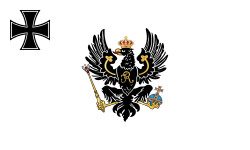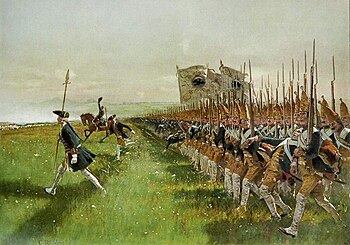You can help expand this article with text translated from the corresponding article in German. (October 2020) Click [show] for important translation instructions.
|
| Prussian Army | |
|---|---|
 War ensign of Kingdom of Prussia, Royal Prussian Army | |
| Active | 1701–1919 |
| Country | |
| Allegiance | House of Hohenzollern |
| Branch | Army |
| Type | Land forces |
| Size | Ranging between 70,000 and 700,000 during the period. |
| Garrison/HQ | Potsdam |
| Patron | King of Prussia |
| Engagements | War of the Spanish Succession Great Northern War War of the Austrian Succession War of the Bavarian Succession
Second Schleswig War Austro-Prussian War (1866) Franco-Prussian War (1870-1871) World War I (1914-1918) |
| Commanders | |
| Notable commanders | Frederick William I Frederick the Great Friedrich Wilhelm von Seydlitz Gerhard von Scharnhorst Gebhard Leberecht von Blücher Ludwig Yorck von Wartenburg August Neidhardt von Gneisenau Carl von Clausewitz Kaiser Wilhelm I Moltke the Elder Albrecht von Roon Friedrich Karl Karl Friedrich von Steinmetz Paul von Hindenburg August von Mackensen Erich Ludendorff Erich von Falkenhayn |

The Royal Prussian Army (1701–1919, ‹See Tfd›German: Königlich Preußische Armee) served as the army of the Kingdom of Prussia. It became vital to the development of Prussia as a European political and military power and within Germany.
The Royal Prussian Army had its roots in the core mercenary forces of Brandenburg-Prussia during the long religious strife of the Thirty Years' War of 1618–1648. Elector Frederick William (1620-1688, reigned 1640-1688), developed it into a viable standing army, while King Frederick William I of Prussia (1688-1740, reigned 1713-1740), dramatically increased its size and improved its doctrines. King Frederick the Great (1712-1786, reigned 1740-1786), a formidable battle commander, led an ]]the disciplined Prussian troops to victory during the 18th century Silesian Wars and greatly increased the prestige and military reputation throughout Europe and among the hodge-podge array of various German states kingdoms,duchies, principalities and free cities of the leadership in the East of the rising Kingdom of Prussia.
However the Prussian Army had become outdated and under-resourced decades later by the beginning of the late 18th century into the early 19th century era to meet the challenge from the west beginning in the political and social upheaval in the French Revolution of 1789-1793, overthrowing of the French monarchy, execution of King Louis XVI, and the Royal House of Bourbon. The continuing strife spilling over French borders of the following French Revolutionary Wars (1792-1802), and then the Napoleonic Wars, and rise of the First French Empire of France under Napoleon Bonaparte (1769-1821), defeated Prussia in the War of the Fourth Coalition in 1806]]-1807.
However, under the subsequent leadership of Gerhard von Scharnhorst (1755-1814), Prussian military reformers began modernizing the Royal Prussian Army, which contributed greatly to the later final defeat and exile of Napoleon during the War of the Sixth Coalition. Conservatives halted some of the reforms, however, and the Prussian Army subsequently became a bulwark of the conservative Prussian royal government.
In the 19th century, the Prussian Army fought successful wars against Kingdom of Denmark in the Second Schleswig War of 1864; versus the Austrian Empire (Austria) in the Austro-Prussian War of 1866; and the Franco-Prussian War of 1870-1871 with the Second French Empire of France, led by Emperor Napoleon III; which allowing Prussia to lead and dominate in the Unification of Germany, establishing the German Empire in 1871. The Royal Prussian Army formed the core of the new larger Imperial German Army, which was replaced by the Reichswehr after the defeat in World War I (1914-1918), in the First German Republic (Weimar Republic) during the 1920s and early 1930s.